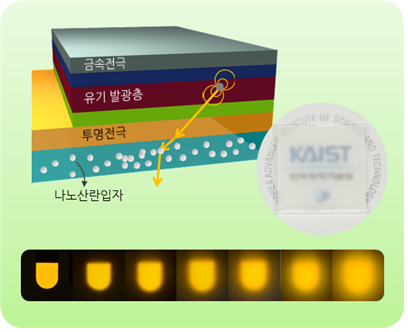Ph.D. candidate Song Jinouk of Yoo Seunghyup’s team succeeded in realizing a highly efficient organic light emitting diode (OLED) corresponding to inorganic LED.
OLED is used as a light source in many mobile devices and display technologies such as high-quality TVs. It has the advantage of being able to make thin and flexible devices. In recent years, many efforts have been made to use OLEDs for lighting and automobile light sources. The efficiency of the light source is very important for such applications. Recently, the efficiency of OLED has been steadily increased due to continuous research and development, and some results have been reported based on the conventional high-efficiency inorganic LED level. However, the research results of such high-efficiency OLEDs have been limited to commercialization due to problems such as hemispherical lenses that hinder the advantages of surface light sources of OLEDs or light extracting nanostructures that hindering the stable operation of the device.
Yoo’s team has focused on introducing nanoparticle-based light scattering layers outside of the device, which is the most feasible technology among the various methods developed for light extraction of OLEDs. Unlike conventional OLED light extraction enhancement studies using light scattering, which have been conducted empirically through repeated experiments, the team has developed a comprehensive and analytical methodology and theoretically predicts structures that can maximize efficiency.
To achieve the maximum efficiency possible by applying a light extraction structure to an OLED, the light extraction structure and the OLED structure must be viewed and optimized as a whole rather than individually. The team first combined the theory of describing the scattering phenomenon mathematically with the OLED emission prediction model to predict the characteristics of a number of devices with various structures in a short time, and based on this, they succeeded in predicting the optimal structure with maximum efficiency theoretically. The researchers have experimentally realized theoretically predicted optimal light scattering film and have succeeded in deriving 56% of external quantum efficiency and 221lm/W of power efficiency by combining it with the device structure using high-efficiency organic light emitting materials. This is the best result with OLED unit device efficiency realized without a large lens or internal light extraction structure.
Professor Yoo said, “Various OLED light extraction efficiency enhancement technologies have been developed, but the possibility of practical use has not been high. This research has systematically presented the OLED implementation method corresponding to the efficiency of the high efficiency LED while utilizing the most meaningful technology in the commercialization.” “This will contribute to the use of OLEDs in the light source for lighting or the sensor of the wearable device, where low power consumption is particularly important.” This technology is expected to contribute to the popularization of OLED lighting and market growth.
This research, which Ph.D. Candidate Song Jinouk participated as the first author, was published in the online edition of “Nature Communications” on August 10. This work was supported in part by the National Research Foundation (NRF) of Korea funded by the Ministry of Science and ICT, and in part by a research program “Technology Development of Low Cost Flexible Lighting Surface”, which is a part of the R&D program of Electronics and Telecommunications Research Institute (ETRI).
Paper: Lensfree OLEDs with over 50% external quantum efficiency via external scattering and horizontally oriented emitters
Link: https://www.nature.com/articles/s41467-018-05671-x

OLED structure combined with external scattering layer